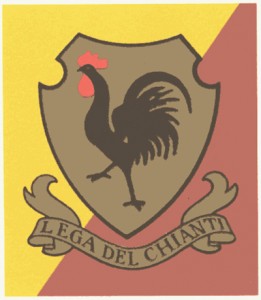
As noted in my post The Good, the Bad, and the Fiasco, the black rooster is the logo of the Chianti Classico growers association, Consorzio del Vino Classico Chianti. The consortium chose the rooster because it is a long time symbol of Chianti, dating back at least as far as the establishment of the Military League of Chianti in 1384. However, that still leaves the question: Why a black rooster?
During the Middle Ages, there were two important cities just north and south of Chianti: Florence and Siena. By the early 13th century these rivals had an established history of diplomatic scheming and bloody battles. Both were interested in controlling the Chianti area that lay between them, and the rooster is part of a legend about how they settled one of their disputes.
As the story goes, the parties were interested in a non-military resolution to the crisis at hand. The plan they came up with was to set the border at the place where two riders, one from each city, met when they simultaneously set out to travel to the other’s city. Lacking radios or synchronized timepieces, the method devised for coordinating the departure times was the first crowing of a rooster on the chosen day.
The Sienese selected a white rooster which they fed well so that it would have plenty of energy for crowing long and loud when dawn broke. The Florentines picked a black rooster which they kept tightly confined and underfed. As a result, Florence’s rooster was in a foul mood and on the day of the contest it began crowing as soon as it was disturbed, a time well before day break. This gave the rider from Florence a large head start. The two met at a point only a short distance outside of Siena (most accounts say 12 kilometers), giving control of Chianti to the Florentines.
Whether the story is true or not, history records that when Siena threatened to attack the town of Montepulciano in 1203, Florence manufactured a diplomatic crisis by laying claim to Tornano, a fortress a few miles north-east of Sienna. The potestà (chief magistrate) of Poggibonsi was asked to arbitrate the dispute, and on June 4, 1203, he gave his decision, moving the border between the two cities to just six miles north of Siena.
We’ll almost certainly never know for sure if a black rooster was involved in the events of 1203 (or any other time in the Florence-Siena rivalry). On the other hand, I’m pretty sure that you’ll never forget what the black rooster means to wine today!
For those interested in history, detailed information on Florence and Siena in the Middle Ages can be found in two e-books available through Google:
A History of Siena by Robert Langton Douglas, with information on the decision of the potestà starting on page 58.
Siena and Southern Tuscany by Edward Hutton, where these events are described starting on the bottom of page 81.
